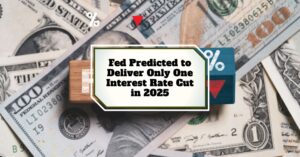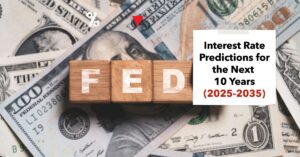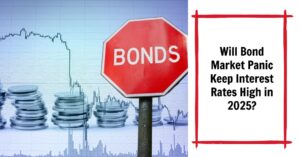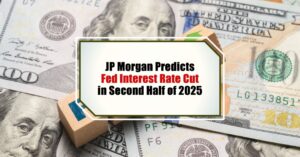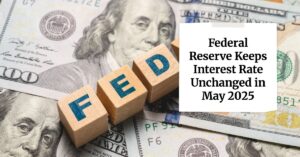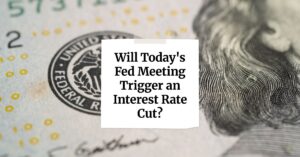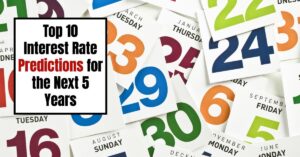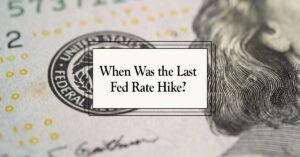The question on everyone's mind in the financial world right now is: when will interest rates come down? Well, according to Atlanta Fed President Raphael Bostic, we might only see one interest rate cut in 2025. This outlook, which he shared recently, hinges largely on the time it will take for the Federal Reserve to fully grasp the economic consequences of the White House's new tariff policies. So, if you're hoping for a significant easing of borrowing costs this year, you might need to adjust your expectations.
Fed Predicted to Deliver Only One Interest Rate Cut in 2025
For a while now, the Fed has been walking a tightrope, trying to bring down inflation without sending the economy into a tailspin. We've seen interest rates stay higher for longer than many initially anticipated. Now, with the added layer of uncertainty from these new tariffs, it seems the Fed is taking an even more cautious approach. Bostic himself adjusted his earlier forecast of two rate cuts down to just one, and it seems his reasoning is pretty sound.
The Tariff Tango: A Waiting Game for the Fed
The core of Bostic's thinking revolves around the fact that understanding the true impact of these tariffs won't be an overnight process. He pointed out that the scale and variety of the proposed tariffs across different sectors and countries are much broader than what was initially anticipated at the start of the year. This isn't just a minor tweak in trade; it's a potentially significant shift that could ripple through the entire economy.
Think about it from a business perspective. If a company suddenly faces higher costs on imported materials due to tariffs, they have a few choices: absorb the cost, try to find alternative (and potentially more expensive or lower quality) suppliers, or pass those costs on to consumers through higher prices. We've already seen some big players, like Walmart, hinting at the possibility of price increases.
This is where the Fed's concern about inflation comes back into play. If businesses across the board start raising prices to offset tariff-related costs, we could see a resurgence of inflationary pressures. And after all the effort to bring inflation down, that's the last thing the Fed wants.
Bostic emphasized that the details of these tariffs are crucial and that it will take three to six months to really get a clear picture of how they're affecting the economy at an aggregate level. This waiting period is why he believes there will be less room than previously expected for interest rate cuts this year. The Fed needs to see the data, analyze the trends, and understand the full implications before making any definitive moves.
More Than Just Numbers: The Human Element of Economic Policy
What I find particularly insightful in Bostic's comments is the recognition of the human element in all of this. He talked about how businesses were caught off guard by the tariff policies, having perhaps expected a different economic agenda. This surprise can lead to hesitation and uncertainty when it comes to investment decisions. If businesses are unsure about future costs and demand due to tariffs, they might be less willing to invest in expansion, hiring, and innovation.
Furthermore, the foreboding that Bostic mentioned – the feeling that the impact of tariffs is coming even if we're not seeing it fully in prices yet – can also influence consumer behavior. If people are worried about higher prices down the line, they might become more cautious with their spending, which could slow down economic growth.
This highlights a key aspect of economic policy that often gets overlooked in dry data and charts: sentiment and expectations matter a lot. If people believe inflation will go up, their behavior can actually contribute to that outcome. This is why the Fed pays close attention to inflation expectations, both in the short and long term.
My Take on the Situation: A Cautious Stance Makes Sense
Personally, I think Bostic's cautious outlook on interest rate cuts is a pragmatic one. The introduction of significant tariffs throws a wrench into the economic machinery, and it's wise for the Fed to take a step back and assess the situation before making any drastic moves on interest rates.
We've seen how quickly economic conditions can change, and rushing into rate cuts before understanding the full impact of these tariffs could have unintended consequences, potentially reigniting inflation or creating new economic imbalances.
The Fed's dual mandate is to maintain price stability and maximum employment. Right now, it seems the focus is more on the inflation side, especially given the uncertainty surrounding tariffs. While a single interest rate cut in 2025 might be disappointing for those hoping for lower borrowing costs, it reflects a careful approach to navigating a complex and evolving economic landscape.
What This Means for You
So, what does this outlook mean for everyday folks and businesses?
- Borrowers: If you're planning on taking out a loan (mortgage, car loan, etc.), don't necessarily count on significantly lower interest rates this year. Plan your finances accordingly.
- Savers: Higher interest rates on savings accounts and fixed-income investments might persist for a bit longer.
- Businesses: Be prepared for potential cost increases due to tariffs and factor that into your pricing and investment strategies. The uncertainty also underscores the importance of flexibility and adaptability.
- Investors: The market might experience some volatility as it digests the implications of the tariff policies and the Fed's cautious stance. Focus on long-term fundamentals and diversification.
Looking Ahead: The Data Will Tell the Tale
Ultimately, the actual path of interest rates in 2025 will depend on the economic data that emerges in the coming months. We'll be closely watching inflation figures, consumer spending, business investment, and of course, the real-world impact of the tariffs. Bostic himself acknowledged that the range of possibilities for the U.S. economy is still quite wide.
While his current leaning is towards one rate cut, the Fed's decisions are data-dependent. If inflation shows persistent signs of easing and the impact of tariffs appears manageable, there could be room for more easing. Conversely, if inflation remains sticky or tariffs lead to significant price pressures, even one rate cut might be off the table.
Bottom Line
Atlanta Fed President Bostic's prediction of only one interest rate cut in 2025 is a significant piece of the puzzle in understanding the future direction of monetary policy. His rationale, rooted in the need to assess the economic impact of new tariffs, highlights the complexities and uncertainties facing the Federal Reserve. While this outlook might adjust as more data becomes available, it serves as a crucial reminder that the path to lower interest rates might be longer and more gradual than some had hoped. Staying informed and understanding the factors influencing the Fed's decisions is key to navigating the economic landscape ahead.
“Position Your Investments for the Next Decade”
With interest rates expected to remain high, smart investors are locking in real estate opportunities now to build long-term passive income and hedge against rising costs.
Norada offers turnkey, fully managed properties in high-demand markets—perfect for building wealth regardless of the rate environment.
HOT NEW LISTINGS JUST ADDED!
Speak to a Norada investment advisor today (No Obligation):
(800) 611-3060
Recommended Read:
- Interest Rate Predictions for the Next 10 Years: 2025-2035
- Will the Bond Market Panic Keep Interest Rates High in 2025?
- Interest Rate Predictions for 2025 by JP Morgan Strategists
- Interest Rate Predictions for Next 2 Years: Expert Forecast
- Fed Holds Interest Rates But Lowers Economic Forecast for 2025
- Fed Indicates No Rush to Cut Interest Rates as Policy Shifts Loom in 2025
- Fed's Powell Hints of Slow Interest Rate Cuts Amid Stubborn Inflation
- Fed Funds Rate Forecast 2025-2026: What to Expect?
- Interest Rate Predictions for 2025 and 2026 by NAR Chief
- Market Reactions: How Investors Should Prepare for Interest Rate Cut
- Interest Rate Predictions for the Next 3 Years
- Impact of Interest Rate Cut on Mortgages, Car Loans, and Your Wallet
- Interest Rate Predictions for Next 10 Years: Long-Term Outlook
- When is the Next Fed Meeting on Interest Rates?
- Interest Rate Cuts: Citi vs. JP Morgan – Who is Right on Predictions?
- More Predictions Point Towards Higher for Longer Interest Rates
